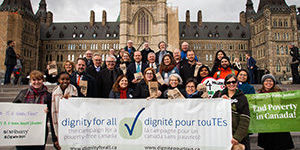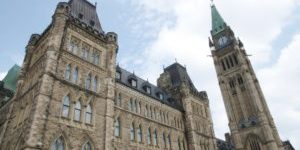Budget 2019 presents important aspirations but lacks prompt implementation
With their last federal Budget ahead of the 2019 election, the Federal government has laid out some important policy pitches. Yet delayed timelines mean pressing issues will not receive needed action.
If this budget had been released in 2016, it would have represented some huge steps forward. With its emphasis on gender equality, deepening efforts towards reconciliation, and notable shifts towards a cleaner economy, it sends positive signals about the priorities the Government of Canada wants to emphasize. But with little more than half a year left in the current mandate, this budget reads as mostly a series of hopeful platitudes towards a future that may never come.
Poverty in Canada
In terms of poverty eradication investments, there are helpful programs that will make some improvements in the lives of those struggling to get by. It is disappointing, however, that the National Poverty Reduction Strategy does not have a more central place in the budget. CPJ would have liked to have seen more investment directly to programs that would strengthen the strategy, rather than a continued piecemeal approach to addressing poverty in Canada.
CPJ is pleased to see a recognition that housing affordability needs to be addressed with further programs directed to first-time homeowners and new rental construction funding (additional $10 billion over nine years). However, the rollout of the spending for the National Housing Strategy has been too slow to address the current housing crisis. The National Housing Strategy is one of the legislation pieces attached to Budget 2019, but it is not clear that it will be rights-based and include needed accountability mechanisms, something that anti-poverty groups have strongly called for.
Budget 2019 includes important first steps to develop a national pharmacare program. However, the creation of a Canadian Drug Agency (provide Health Canada with $35 million over four years, starting in 2019–20), a national formulary, and a national strategy for high-cost drugs for rare diseases ($1 billion over two years, starting in 2022–23, with up to $500 million per year ongoing) must reflect a level of urgency to meaningfully address the needs of people in Canada struggling under crippling costs.
There are also some important investments for First Nations, Metis, and Inuit communities, including increased funds to implement Jordan’s Principle ($1.2 billion over three years, beginning in 2019–20), enhancements to infrastructure for safe drinking water (an additional $739 million over five years, beginning in 2019–20, with $184.9 million per year ongoing), investments in Nutrition North and mental health and Inuit suicide prevention supports ($50 million over 10 years, starting in 2019–20, with $5 million per year ongoing), and supports for urban Indigenous residents ($60 million over five years, beginning in 2019–20, to support capital infrastructure investments in Friendship Centres). However, again, these needs are so urgent that implementation and immediate rollout will be key, along with additional investments.
Ecological Justice
The federal government has acknowledged climate change as a global crisis that requires immediate, far-reaching action. Yet, under the exhilarating heading of “fulfilling Canada’s G20 commitment [to phase-out fossil fuel subsidies],” there is no fulfillment to be found. Instead, they reiterate a June 2018 peer review agreement with Argentina and suggest that they have yet to even develop “a list of federal fossil fuel subsidies.” The incongruence of this continued funding – which research suggests is in the order of at least $1.5 billion annually– is staggering, especially in light of the limited new investments in just transition funding.
Climate change requires a move away from coal-fired electricity generation. Budget 2019 had the benefit of the March 11 recommendations of the Task Force on Just Transition for Canadian Coal Power Workers and Communities, but chose only to maintain the $35 million over five years allocated in 2018 for worker transition centres. There was also $150 million for an infrastructure fund, but only beginning in 2020. Hopefully, some of the Canada Training Benefit’s $1.7 billion over five years will further assist workers as they transition to new jobs, and preliminary efforts towards a just transition will be expanded to include the oil and gas industry.
The federal carbon pollution pricing backstop remains set to stall in 2022 despite the science-based evidence that its effectiveness requires that it go well beyond $50/tonne. What is more, alongside today’s budget, the Department of Finance announced that they are working to “refine” the carbon pricing pollution system by incorporating additional exemptions.
Despite these shortcomings, it is important to acknowledge the $2.2 billion allocated as a one-time transfer to assist municipalities and First Nations communities with immediate infrastructure needs, the $1.01 billion to enhance the energy efficiency of buildings, and the establishment of a new Canadian “target to sell 100 per cent zero-emission vehicles [ZEV] by 2040, with sales goals of 10 per cent by 2025 and 30 per cent by 2030 along the way.” To get there, the federal government has allocated $130 million over five years for recharging and refuelling stations, $5 million over five years for work towards a voluntary manufacturers ZEV sales target, and $300 million over three years for a new incentive rebate for consumers who purchase ZEVs.
Refugee Rights
Budget 2019 offers little to advance refugee rights in Canada. There are some minimal efforts to ameliorate some of the hurdles facing newcomers. These include providing funding to Immigration, Refugees and Citizenship Canada (IRCC) aimed at increasing the number of IRCC call centre agents for more effective responses to inquiries. The government has also committed to protecting potential newcomers by investing $51.9 million over 5 years towards initiatives aimed at protecting newcomers from exploitative immigration consultants. Further that, there is a proposition to introduce legislation and make amendments to the Immigration and Refugee Protection Act and the Citizenship Act so that these efforts can be implemented. Lastly, there are some elements of innovation in providing new resources for legal aid pertaining to refugees and immigration but rooted in previous funding. These provisions are minimal at best.
The decision to implement a Border Enforcement Strategy to the tune of $1.18 billion over five years in 2019-20 followed by $55 million per year thereafter, highlights that the Government wishes to increase their border control by increasing interception and deportation of irregular border crossers. This new strategy contradicts CPJ’s call for the federal government to rescind the Canada-US Safe Third Country Agreement, “Budget 2019 proposes to introduce legislative amendments to the Immigration and Refugee Protection Act to better manage, discourage and prevent irregular migration.” Rather, such a strategy would further limit the welcoming nature they claim Canada is proud of. The use of language that suggests potential claimants are not genuine in their reasons for seeking asylum or that they pose a threat of exploitation to our system is concerning, “To ensure that our asylum system is fair and effective—supporting Canada’s reputation as a country that is welcoming as well as governed by the rule of law—we will invest in a comprehensive Border Enforcement Strategy, to better detect and intercept people who cross into Canada irregularly and those that attempt to exploit our immigration system.”
There is a critical irony in the call, “To better counter racism in Canada, we’re moving forward with a new Anti-Racism Strategy. And in recognition of the United Nations Decade for People of African Descent,” while actively preventing racialized and largely, Black refugees, from making a claim in Canada.
This new strategy combined with the limited investment in refugees overall is disappointing to see in the pursuit of justice for the rights of refugees.
Election Interference
Ahead of the October 21, 2019 federal election, and in light of increased concern over foreign election tampering, it is worth noting the considerable commitment by the federal government to invest $30.2 million over five years towards the safeguarding of democratic institutions. Among these measures are $4.2 million over three years to protect against cyber attacks, $2.1 million over the same period to boost cross-national information sharing, and $19.4 million over four years towards a “Digital Democracy Project.”
Gender Lens
Budget 2019 offers some important pieces on gender equality for people in Canada, starting with an investment of $1.0 million over two years that begins in 2019–20 to support the integration of GBA+ in program design. This will provide much-needed improvement to data collection and reporting efforts.
The significant investment in women’s organizations of $160 million over 5 years starting in 2019-20 is a welcomed initiative for the newly minted Department of Women and Gender Equality. This presents a great opportunity for grassroots organizations and it is imperative that the government adhere to an intersectional approach for this funding to see the advancement of gender equality reap tangible and inclusive results.




